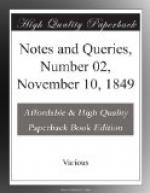Several of these descriptions are highly curious; particularly the last item, which describes one of the “glossed” psalters as being “in pawn,” a fact which, in itself, tells a history of the then condition of the house.
The first document, taken in connection with that referred to by Mr. Hunter would seem to establish the existence of a system of interchanging the literary wealth of monastic establishments, and thereby greatly extending the advantages of their otherwise scanty stores. Both are executed with all the legal forms used in the most important transactions, which would support the opinion of their not {23} being special instances: but they are, in either case, curious and satisfactory evidence of the care and caution exercised by the monks in cases where their books were concerned; and one cannot but regret that when the time came that the monasterias were destined to be dissolved, and their books torn and scattered to the winds, no attention was paid to Bale’s advice for the formation of “one solemne library in every shire of England.”
JOSEPH BURTT
[1] The information given
of this house by Dugdale is very
scanty. It could surely
be added to considerably.
[2] London, 1831. quarto. See also a Paper by Mr. Halliwell in the Archaeologia, xxvii. p. 455., and Sir Francis Palgrave’s Introduction to Documents and Records illustrating the History of Scotland, pp. xcvi.—cxvi., for extracts from the historical chronicles preserved in the monasteries, &c.
[3] The formula of this date, “anno R.R.E. septimo,” would at first sight be considered to refer to the preceding reign; but the list is merely a memorandum on the dorse of a completely executed instrument dated A.D. 1300, which it is highly improbable that it preceded. The style of Edward II. is often found as above, though not usually so.
* * * * *
PEDLAR’S SONG ATTRIBUTED TO SHAKSPERE, AND TRADITION CONNECTED WITH SHAKSPERE’S “HAMLET.”
The following verses, which would form a very appropriate song for Autolycus, were arranged as a glee for three voices by Dr. Wilson about the year 1667. They are published in Playford’s Musical Companion in 1673; in Warren’s Collection of Glees and Catches; and in S. Webbe’s Conveto Harmonico. The words were, I believe, first ascribed to Shakspere by Clark, in 1824, in his Words of Glees, Madrigals, &c.; but he has not given his authority for so doing. It has been stated that they have since been discovered in a common-place book written about Shakspere’s time, with his name attached to them, and with this indirect evidence in favour of their being written by him, that the other pieces in the collection are attributed to their proper writers. The late Mr. Douce, who was inclined to believe the song to have been written by Shakspere,




